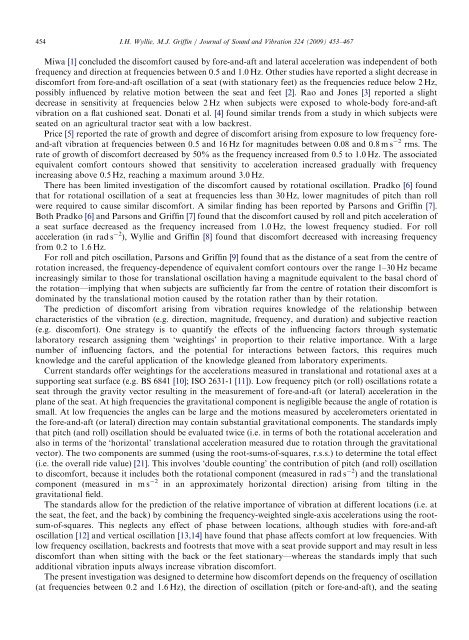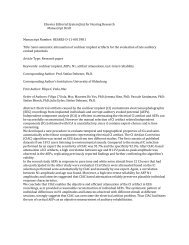Discomfort from sinusoidal oscillation in the pitch and fore-and-aft ...
Discomfort from sinusoidal oscillation in the pitch and fore-and-aft ...
Discomfort from sinusoidal oscillation in the pitch and fore-and-aft ...
Create successful ePaper yourself
Turn your PDF publications into a flip-book with our unique Google optimized e-Paper software.
454<br />
ARTICLE IN PRESS<br />
I.H. Wyllie, M.J. Griff<strong>in</strong> / Journal of Sound <strong>and</strong> Vibration 324 (2009) 453–467<br />
Miwa [1] concluded <strong>the</strong> discomfort caused by <strong>fore</strong>-<strong>and</strong>-<strong>aft</strong> <strong>and</strong> lateral acceleration was <strong>in</strong>dependent of both<br />
frequency <strong>and</strong> direction at frequencies between 0.5 <strong>and</strong> 1.0 Hz. O<strong>the</strong>r studies have reported a slight decrease <strong>in</strong><br />
discomfort <strong>from</strong> <strong>fore</strong>-<strong>and</strong>-<strong>aft</strong> <strong>oscillation</strong> of a seat (with stationary feet) as <strong>the</strong> frequencies reduce below 2 Hz,<br />
possibly <strong>in</strong>fluenced by relative motion between <strong>the</strong> seat <strong>and</strong> feet [2]. Rao <strong>and</strong> Jones [3] reported a slight<br />
decrease <strong>in</strong> sensitivity at frequencies below 2 Hz when subjects were exposed to whole-body <strong>fore</strong>-<strong>and</strong>-<strong>aft</strong><br />
vibration on a flat cushioned seat. Donati et al. [4] found similar trends <strong>from</strong> a study <strong>in</strong> which subjects were<br />
seated on an agricultural tractor seat with a low backrest.<br />
Price [5] reported <strong>the</strong> rate of growth <strong>and</strong> degree of discomfort aris<strong>in</strong>g <strong>from</strong> exposure to low frequency <strong>fore</strong><strong>and</strong>-<strong>aft</strong><br />
vibration at frequencies between 0.5 <strong>and</strong> 16 Hz for magnitudes between 0.08 <strong>and</strong> 0.8 m s 2 rms. The<br />
rate of growth of discomfort decreased by 50% as <strong>the</strong> frequency <strong>in</strong>creased <strong>from</strong> 0.5 to 1.0 Hz. The associated<br />
equivalent comfort contours showed that sensitivity to acceleration <strong>in</strong>creased gradually with frequency<br />
<strong>in</strong>creas<strong>in</strong>g above 0.5 Hz, reach<strong>in</strong>g a maximum around 3.0 Hz.<br />
There has been limited <strong>in</strong>vestigation of <strong>the</strong> discomfort caused by rotational <strong>oscillation</strong>. Pradko [6] found<br />
that for rotational <strong>oscillation</strong> of a seat at frequencies less than 30 Hz, lower magnitudes of <strong>pitch</strong> than roll<br />
were required to cause similar discomfort. A similar f<strong>in</strong>d<strong>in</strong>g has been reported by Parsons <strong>and</strong> Griff<strong>in</strong> [7].<br />
Both Pradko [6] <strong>and</strong> Parsons <strong>and</strong> Griff<strong>in</strong> [7] found that <strong>the</strong> discomfort caused by roll <strong>and</strong> <strong>pitch</strong> acceleration of<br />
a seat surface decreased as <strong>the</strong> frequency <strong>in</strong>creased <strong>from</strong> 1.0 Hz, <strong>the</strong> lowest frequency studied. For roll<br />
acceleration (<strong>in</strong> rad s 2 ), Wyllie <strong>and</strong> Griff<strong>in</strong> [8] found that discomfort decreased with <strong>in</strong>creas<strong>in</strong>g frequency<br />
<strong>from</strong> 0.2 to 1.6 Hz.<br />
For roll <strong>and</strong> <strong>pitch</strong> <strong>oscillation</strong>, Parsons <strong>and</strong> Griff<strong>in</strong> [9] found that as <strong>the</strong> distance of a seat <strong>from</strong> <strong>the</strong> centre of<br />
rotation <strong>in</strong>creased, <strong>the</strong> frequency-dependence of equivalent comfort contours over <strong>the</strong> range 1–30 Hz became<br />
<strong>in</strong>creas<strong>in</strong>gly similar to those for translational <strong>oscillation</strong> hav<strong>in</strong>g a magnitude equivalent to <strong>the</strong> basal chord of<br />
<strong>the</strong> rotation—imply<strong>in</strong>g that when subjects are sufficiently far <strong>from</strong> <strong>the</strong> centre of rotation <strong>the</strong>ir discomfort is<br />
dom<strong>in</strong>ated by <strong>the</strong> translational motion caused by <strong>the</strong> rotation ra<strong>the</strong>r than by <strong>the</strong>ir rotation.<br />
The prediction of discomfort aris<strong>in</strong>g <strong>from</strong> vibration requires knowledge of <strong>the</strong> relationship between<br />
characteristics of <strong>the</strong> vibration (e.g. direction, magnitude, frequency, <strong>and</strong> duration) <strong>and</strong> subjective reaction<br />
(e.g. discomfort). One strategy is to quantify <strong>the</strong> effects of <strong>the</strong> <strong>in</strong>fluenc<strong>in</strong>g factors through systematic<br />
laboratory research assign<strong>in</strong>g <strong>the</strong>m ‘weight<strong>in</strong>gs’ <strong>in</strong> proportion to <strong>the</strong>ir relative importance. With a large<br />
number of <strong>in</strong>fluenc<strong>in</strong>g factors, <strong>and</strong> <strong>the</strong> potential for <strong>in</strong>teractions between factors, this requires much<br />
knowledge <strong>and</strong> <strong>the</strong> careful application of <strong>the</strong> knowledge gleaned <strong>from</strong> laboratory experiments.<br />
Current st<strong>and</strong>ards offer weight<strong>in</strong>gs for <strong>the</strong> accelerations measured <strong>in</strong> translational <strong>and</strong> rotational axes at a<br />
support<strong>in</strong>g seat surface (e.g. BS 6841 [10]; ISO 2631-1 [11]). Low frequency <strong>pitch</strong> (or roll) <strong>oscillation</strong>s rotate a<br />
seat through <strong>the</strong> gravity vector result<strong>in</strong>g <strong>in</strong> <strong>the</strong> measurement of <strong>fore</strong>-<strong>and</strong>-<strong>aft</strong> (or lateral) acceleration <strong>in</strong> <strong>the</strong><br />
plane of <strong>the</strong> seat. At high frequencies <strong>the</strong> gravitational component is negligible because <strong>the</strong> angle of rotation is<br />
small. At low frequencies <strong>the</strong> angles can be large <strong>and</strong> <strong>the</strong> motions measured by accelerometers orientated <strong>in</strong><br />
<strong>the</strong> <strong>fore</strong>-<strong>and</strong>-<strong>aft</strong> (or lateral) direction may conta<strong>in</strong> substantial gravitational components. The st<strong>and</strong>ards imply<br />
that <strong>pitch</strong> (<strong>and</strong> roll) <strong>oscillation</strong> should be evaluated twice (i.e. <strong>in</strong> terms of both <strong>the</strong> rotational acceleration <strong>and</strong><br />
also <strong>in</strong> terms of <strong>the</strong> ‘horizontal’ translational acceleration measured due to rotation through <strong>the</strong> gravitational<br />
vector). The two components are summed (us<strong>in</strong>g <strong>the</strong> root-sums-of-squares, r.s.s.) to determ<strong>in</strong>e <strong>the</strong> total effect<br />
(i.e. <strong>the</strong> overall ride value) [21]. This <strong>in</strong>volves ‘double count<strong>in</strong>g’ <strong>the</strong> contribution of <strong>pitch</strong> (<strong>and</strong> roll) <strong>oscillation</strong><br />
to discomfort, because it <strong>in</strong>cludes both <strong>the</strong> rotational component (measured <strong>in</strong> rad s 2 ) <strong>and</strong> <strong>the</strong> translational<br />
component (measured <strong>in</strong> m s 2 <strong>in</strong> an approximately horizontal direction) aris<strong>in</strong>g <strong>from</strong> tilt<strong>in</strong>g <strong>in</strong> <strong>the</strong><br />
gravitational field.<br />
The st<strong>and</strong>ards allow for <strong>the</strong> prediction of <strong>the</strong> relative importance of vibration at different locations (i.e. at<br />
<strong>the</strong> seat, <strong>the</strong> feet, <strong>and</strong> <strong>the</strong> back) by comb<strong>in</strong><strong>in</strong>g <strong>the</strong> frequency-weighted s<strong>in</strong>gle-axis accelerations us<strong>in</strong>g <strong>the</strong> rootsum-of-squares.<br />
This neglects any effect of phase between locations, although studies with <strong>fore</strong>-<strong>and</strong>-<strong>aft</strong><br />
<strong>oscillation</strong> [12] <strong>and</strong> vertical <strong>oscillation</strong> [13,14] have found that phase affects comfort at low frequencies. With<br />
low frequency <strong>oscillation</strong>, backrests <strong>and</strong> footrests that move with a seat provide support <strong>and</strong> may result <strong>in</strong> less<br />
discomfort than when sitt<strong>in</strong>g with <strong>the</strong> back or <strong>the</strong> feet stationary—whereas <strong>the</strong> st<strong>and</strong>ards imply that such<br />
additional vibration <strong>in</strong>puts always <strong>in</strong>crease vibration discomfort.<br />
The present <strong>in</strong>vestigation was designed to determ<strong>in</strong>e how discomfort depends on <strong>the</strong> frequency of <strong>oscillation</strong><br />
(at frequencies between 0.2 <strong>and</strong> 1.6 Hz), <strong>the</strong> direction of <strong>oscillation</strong> (<strong>pitch</strong> or <strong>fore</strong>-<strong>and</strong>-<strong>aft</strong>), <strong>and</strong> <strong>the</strong> seat<strong>in</strong>g
















